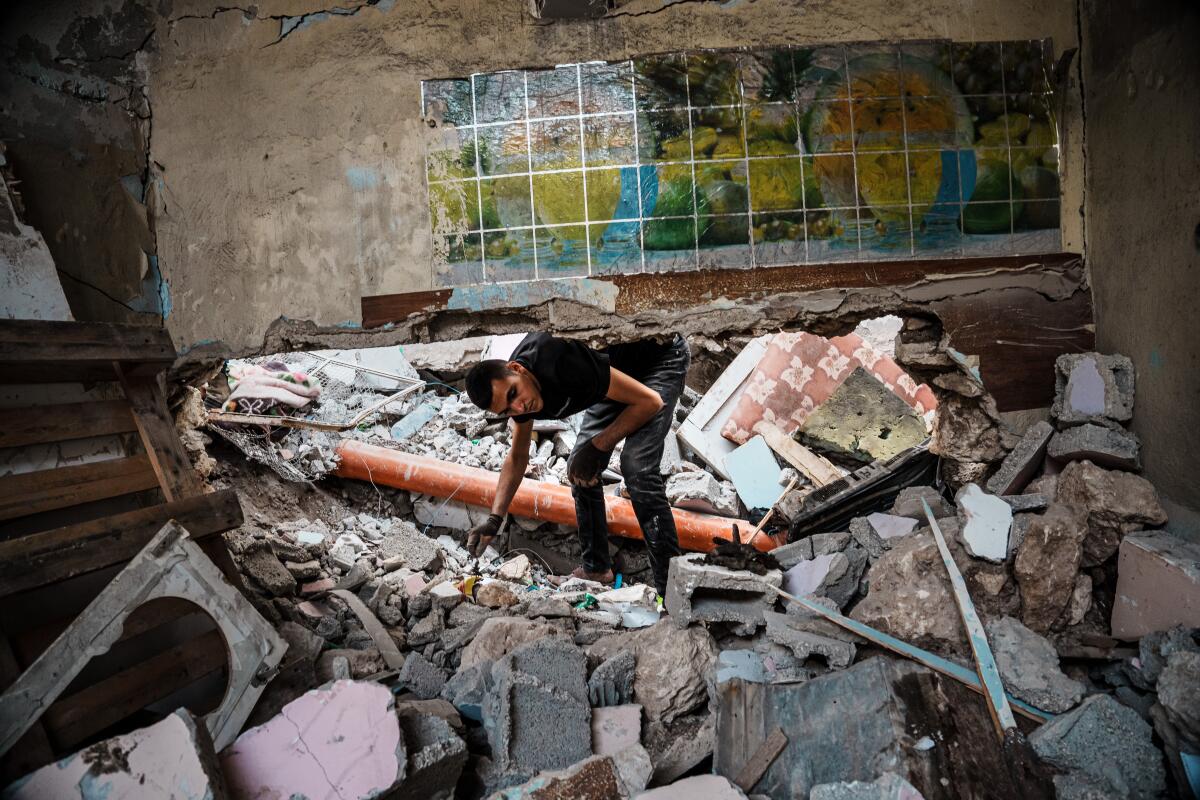Israel strikes Gaza, Syria and West Bank as war with Hamas threatens to ignite other fronts

- Share via
RAFAH, Gaza Strip — A second aid convoy destined for Palestinian civilians reached the Gaza Strip on Sunday, as Israeli warplanes struck targets across the Palestinian enclave, as well as two airports in Syria and a mosque in the occupied West Bank allegedly used by militants, as the 2-week-old war with Hamas threatened to spiral into a broader conflict.
Israel has traded fire with Lebanon’s Hezbollah militant group on a near-daily basis since the war began, and tensions are soaring in the Israeli-occupied West Bank, where Israeli forces have battled militants in refugee camps and carried out two airstrikes in recent days.
Israeli Prime Minister Benjamin Netanyahu told troops that if Hezbollah launches a war against Israel, “it will make the mistake of its life. We will cripple it with a force it cannot even imagine and the consequences for it and the Lebanese state will be devastating.”
For days, Israel has seemed to be on the verge of launching a ground offensive in Gaza as part of its response to Hamas’ deadly Oct. 7 rampage, in which the militants slaughtered more than 1,400 people, mostly civilians, and took more than 200 hostages. Tanks and tens of thousands of troops have massed at the border, and Israeli leaders have spoken of an undefined next stage in operations.
Column: Biden says the U.S. must help Israel and Ukraine succeed — he’s staking his reputation on it
Presidents are often measured by how they lead in times of crisis. In the wars in Israel and Ukraine, Biden has put his place in history on the line.
Israel’s military spokesman, Rear Adm. Daniel Hagari, said the military had increased airstrikes across Gaza to hit targets so as to reduce the risk to troops in the next stage of the war.

Hamas said it fought with Israeli forces near Khan Yunis in southern Gaza and destroyed a tank and two bulldozers.
Late Sunday, Hagari announced that a soldier was killed, and three others wounded, during a raid inside Gaza carried out as part of efforts to rescue the hostages seized in the Oct. 7 attack. He said the soldiers were hit by an antitank missile. It was not immediately known whether the soldiers were inside Gaza when they were shot.
On Saturday, 20 trucks entered Gaza in the first aid shipment into the territory since Israel imposed a complete siege two weeks ago.
Egypt’s state-run media reported 17 more trucks crossing into Gaza on Sunday, but the United Nations said none had crossed.
“Until now, there is no convoy,” said Juliette Touma, spokeswoman for the U.N. agency for Palestinian refugees.
Associated Press journalists saw seven fuel trucks head into Gaza, but Touma and the Israeli military said that those trucks were taking fuel that had been stored on the Gaza side of the crossing deeper into the territory, and that no fuel had entered from Egypt.

In a sign of how precarious any movement of aid remains, two Egyptian officials said Israeli shells hit close to the Egyptian side of the crossing Sunday, wounding nine Egyptian border guards. The officials spoke on condition of anonymity because they were not authorized to brief the media.
The Israeli military said a tank had accidentally fired and hit an Egyptian post, and the incident was being investigated. It apologized for the incident.
Relief workers said far more was needed to address the spiraling humanitarian crisis in Gaza, where half the territory’s 2.3 million people have fled their homes. The U.N. humanitarian agency, known as OCHA, said Saturday’s convoy carried about 4% of an average day’s imports before the war and “a fraction of what is needed after 13 days of complete siege.”
The Israeli military said the humanitarian situation was “under control,” as OCHA called for 100 trucks a day to enter.
Israel repeated its calls for people to leave northern Gaza and also air-dropped leaflets advising them to do so. It says an estimated 700,000 have already fled, but hundreds of thousands remain. That would raise the risk of mass civilian casualties in any ground offensive.
Israeli military officials say that Hamas’ infrastructure and underground tunnel system are concentrated in Gaza City, in the north, and that the next stage of the offensive will include unprecedented force there. Israel says it wants to crush Hamas, but officials have also spoken of carving out a possible buffer zone to keep Palestinians from approaching the border.
Hospitals packed with patients and displaced people are running low on medical supplies and fuel for generators, forcing doctors to perform surgeries with sewing needles, using vinegar as disinfectant, and without anesthesia.
The World Health Organization says at least 130 premature babies are at “grave risk” because of a shortage of generator fuel. It said seven hospitals in northern Gaza have been forced to shut down due to damage from strikes, lack of power and supplies, or Israeli evacuation orders.
Shortages in critical supplies, including ventilators, are forcing doctors to ration treatment, said Dr. Mohammed Qandeel, who works in Khan Yunis’ Nasser Hospital. Dozens of patients continue to arrive and are treated in crowded, darkened corridors, as hospitals preserve electricity for intensive care units.
“It’s heartbreaking,” Qandeel told the AP. “Every day, if we receive 10 severely injured patients we have to manage with maybe three or five ICU beds available.”
Palestinians sheltering in U.N.-run schools and tent camps are running low on food and drinking dirty water. A power blackout has crippled water and sanitation systems. OCHA said cases of chickenpox, scabies and diarrhea are on the rise because of the lack of clean water.
Heavy airstrikes were reported across Gaza, including in the southern part of the coastal strip, where Israel has told civilians to seek refuge. At the Aqsa hospital in Deir al Balah, south of the evacuation line, several bodies wrapped in white shrouds were lined up outside on the ground.
Khalil Degran, a hospital official, said more than 90 bodies had been brought in since early Sunday, as the sound of nearby bombing echoed behind him. He said 180 wounded people had arrived, mostly children, women and elderly people who had been displaced from other areas.
Airstrikes also targeted the marketplace in the Nuseirat refugee camp. Witnesses said at least a dozen people were killed.
Israel’s military has said it is striking Hamas members and installations, but does not target civilians. Palestinian militants have fired more than 7,000 rockets at Israel, according to the military, and Hamas says it targeted Tel Aviv early Sunday.
More than 1,400 people in Israel have been killed in the war — mostly civilians massacred during the initial Hamas attack. At least 212 people were captured and taken back to Gaza, including men, women, children and older adults. Two Americans were released Friday in what Hamas said was a humanitarian gesture.
More than 4,600 people have been killed in Gaza, according to the Hamas-run Health Ministry. That includes the disputed toll from a hospital explosion.
Syrian state media meanwhile reported that Israeli airstrikes have targeted the international airports in the capital, Damascus, and the northern city of Aleppo. The strikes killed one person and damaged the runways, putting them out of service, the media reported.
Israel has carried out several strikes in Syria, including on the airports, since the war began. Israel rarely acknowledges individual strikes, but says it acts to prevent Hezbollah and other militant groups from bringing in arms from Iran, which also supports Hamas.
In Lebanon, Hezbollah said six of its fighters were killed Saturday, and the group’s deputy leader, Sheikh Naim Kassem, warned that Israel would pay a high price if it starts a ground offensive in Gaza. Israel struck Hezbollah targets Sunday in response to rocket fire, the military said.
Israel also announced evacuation plans for 14 more communities near the Lebanese border. Kiryat Shmona’s 20,000 people were told to evacuate last week.
In the Israeli-occupied West Bank, 93 Palestinians have been killed — including eight Sunday — in clashes with Israeli troops, arrest raids and attacks by Jewish settlers since Hamas’ multipronged assault, according to the Palestinian Authority Health Ministry. Israeli forces have closed crossings into the territory and checkpoints between cities, measures they say are aimed at preventing attacks. Israel says it has arrested more than 700 Palestinians since Oct. 7, including 480 suspected Hamas members.
Among the dead were two killed in an airstrike on a mosque in the town of Jenin, which has seen heavy gun battles over the last year.
The Israeli military said the mosque compound belonged to Hamas and Islamic Jihad militants who had carried out several attacks in recent months and were planning another one.
The internationally recognized Palestinian Authority administers parts of the West Bank and cooperates with Israel on security, but it is deeply unpopular and has been the target of violent Palestinian protests.
More to Read
Sign up for Essential California
The most important California stories and recommendations in your inbox every morning.
You may occasionally receive promotional content from the Los Angeles Times.











